The New Artisan Bread in Five Minutes a Day Master Recipe! (Back to Basics updated)
This is one of the site’s most popular posts. Why? It answers many of the questions that you asked, with the answers incorporated The New Artisan Bread in Five Minutes a Day. Thank you all for making this new edition possible–readers are where the new ideas come from. If you’re having trouble getting this recipe to turn out the way you’d like, check out the troubleshooting tips on the FAQs page here.
For the Master Recipe…
If you’re new to the site, welcome, and thank you for trying the bread. The updated edition (2013) has lots of material that wasn’t in the original Artisan Bread in Five Minutes a Day (2007):
—More color pictures, there are 40 now (compared with 8), and 100 B+W instructionals
—A gluten-free chapter
—An expanded Tips and Techniques section
—Weight equivalents for every dough–for those of you with digital scales at home (optional!)
—Instructions for adjusting yeast and salt to your taste. And we decreased our standard yeast amount to 1 tablespoon (previously used 1.5 tablespoons for four pounds of dough).
—And 30 new recipes, including crock pot bread, a whole wheat variation that lets you increase the whole grain, rolls, panini, and more. About 130 more pages than our first edition.
As we bake through the basic Master recipe from NewABin5 we’ll try to answer some of the most frequently asked questions. The goal is to create a large batch of dough that stores in the refrigerator for up to two weeks. That’s why our method saves you so much time– all the mixing and prep is divided over four one-pound loaves.
Master Recipe from The New Artisan Bread in Five Minutes a Day: The Discovery That Revolutionizes Home Baking:
3 cups (1 1/2 pounds/680 grams) lukewarm water (you can use cold water, but it will take the dough longer to rise. Just don’t use hot water or you may kill the yeast)
1 tablespoon granulated yeast ( you can use any kind of yeast including products labeled as instant, “quick,” rapid rise, bread machine, active dry, or even fresh cake yeast (which isn’t granulated)*. You can also decrease the amount of yeast in the recipe by following the directions here. Or you can bake with a sour dough starter, see instructions here.)
*If you use cake yeast you will need 1.3 ounces (37g).
1 to 1 1/2 tablespoons Morton Kosher Salt (adjust to suit your taste or eliminate it all together. Find more information here)
6 1/2 cups (2 pounds/910 grams) all-purpose flour (the recipe’s tested with typical supermarket flour. If you use a higher protein flour check here)
Mixing the dough:
In a 5 or 6 quart bowl or lidded dough bucket (the lid is sold separately), dump in the water, and add the yeast and salt.
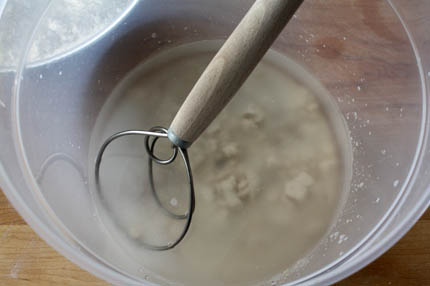
Because we are mixing in the flour so quickly it doesn’t matter that the salt and yeast are thrown in together.
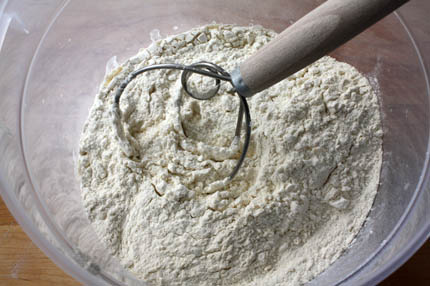
Dump in the flour all at once and stir with a long handled wooden spoon or a Danish Dough Whisk which is one of the tools that makes the job so much easier!
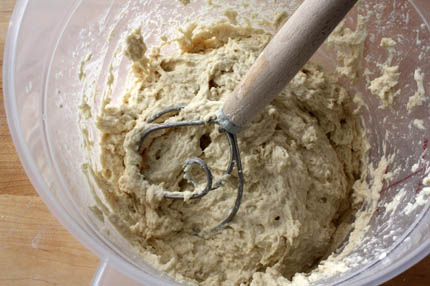
Stir it until all of the flour is incorporated into the dough, as you can see it will be a wet rough dough.
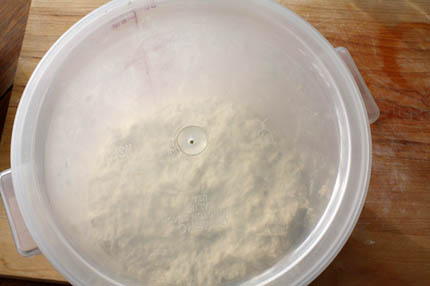
Put the lid on the container, but do not snap it shut. You want the gases from the yeast to escape (you can put a little hole in the top of the lid so that you can close the lid and still allow the gases to get out. It doesn’t take much of a hole…
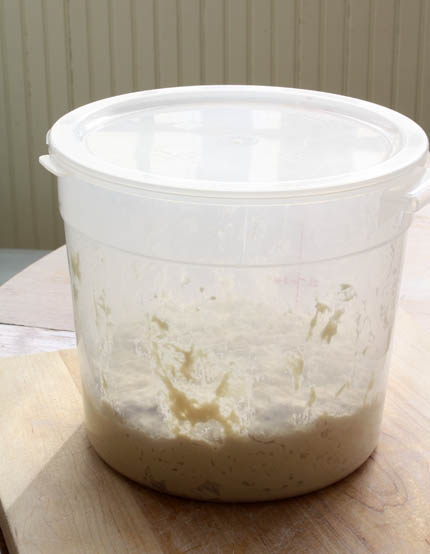
Allow the dough to sit at room temperature for about 2 hours to rise (it may take longer). When you first mix the dough it will not occupy much of the container.
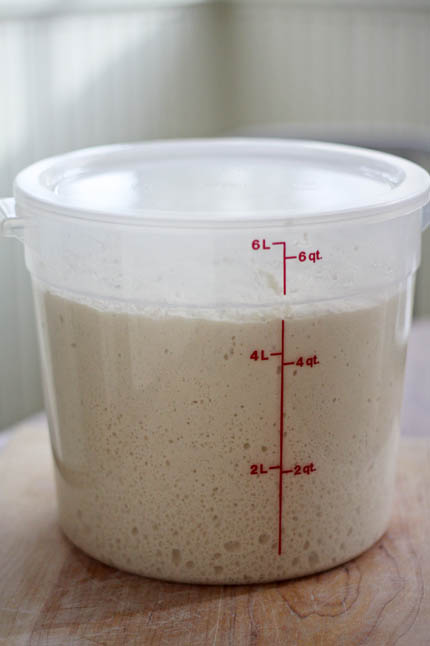
But, after the initial 2 hour rise it will pretty much fill it. (If you have decreased the yeast you will have to let it go longer than 2 hours.) DO NOT PUNCH DOWN THE DOUGH! Just let it settle by itself.
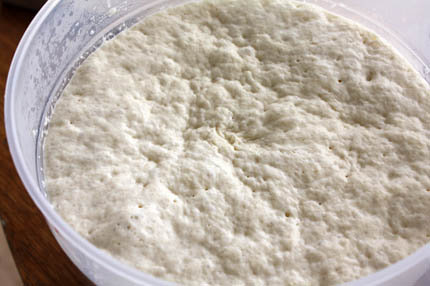
The dough will be flat on the top and some of the bubbles may even appear to be popping. (If you intend to refrigerate the dough after this stage it can be placed in the refrigerator even if the dough is not perfectly flat. The yeast will continue to work even in the refrigerator.) The dough can be used right after the initial 2 hour rise, but it is much easier to handle when it is chilled. It is intended for refrigeration and use over the next two weeks, ready for you anytime. For the first two days of storage, be sure to leave the lid open a crack, to allow gasses to escape. After that, you can usually snap down the lid on plastic contains without problems, because they’re usually not entirely airtight. BUT, DON’T SEAL GLASS CONTAINERS OR THEY MIGHT SHATTER. The flavor will deepen over that time, developing sourdough characteristics.
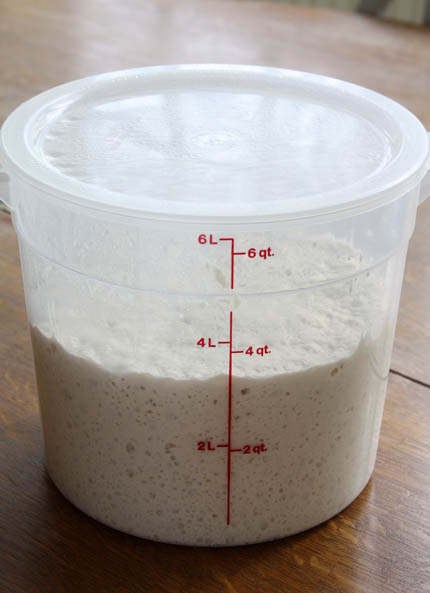
The next day when you pull the dough out of the refrigerator you will notice that it has collapsed and this is totally normal for our dough. It will never rise up again in the container.
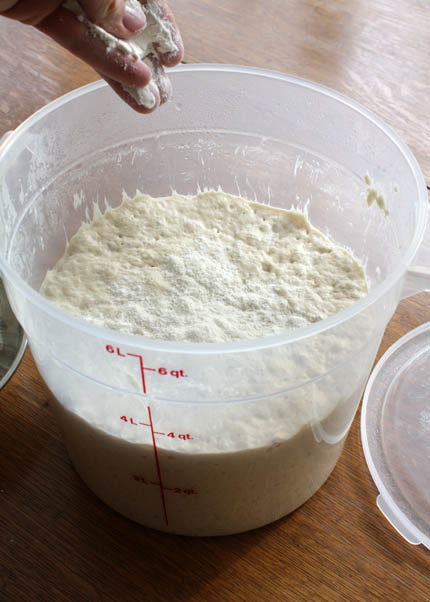
Dust the surface of the dough with a little flour, just enough to prevent it from sticking to your hands when you reach in to pull a piece out.
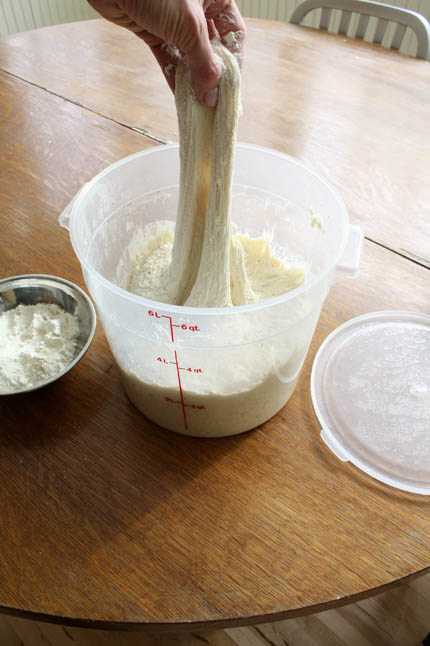
You should notice that the dough has a lot of stretch once it has rested. (If your dough breaks off instead of stretching like this your dough is probably too dry and you can just add a few tablespoons of water and let it sit again until the dough absorbs the additional water.)
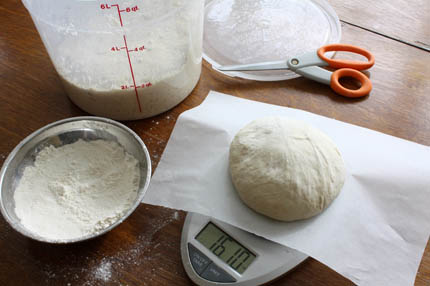
Cut off a 1-pound piece of dough using kitchen shears* and form it into a ball. This video shows the technique for shaping this very wet dough.
Place the ball on a sheet of parchment paper… (or rest it on a generous layer of corn meal on top of a pizza peel.)
*Sewing Shears can be nice because of the long blade. I just dedicated a pair to the kitchen.
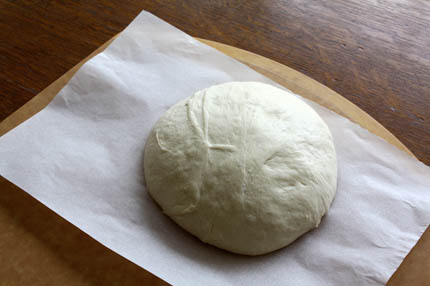
Let the dough rest for at least 40 minutes, (although letting it go 60 or even 90 minutes will give you a more open hole structure in the interior of the loaf. This may also improve the look of your loaf and prevent it from splitting on the bottom.) You will notice that the loaf does not rise much during this rest, in fact it may just spread sideways, this is normal for our dough.
You can also try our “refrigerator rise trick,” shaping the loaves and then immediately refrigerating them overnight. By morning, they’ll have risen and are ready for the oven after a brief room-temp rest while the oven preheats (click for instructions).
Preheat the oven to 450 degrees F. with a Baking Stone* on the center rack, with a metal broiler tray on the bottom (never use a glass vessel for this or it will shatter), which will be used to produce steam. (The tray needs to be at least 4 or 5 inches away from your stone to prevent it from cracking.)
*(or Cast Iron Pizza Pan– which will never crack and conducts heat really well. Be careful to dry it after rinsing with water or it will rust)
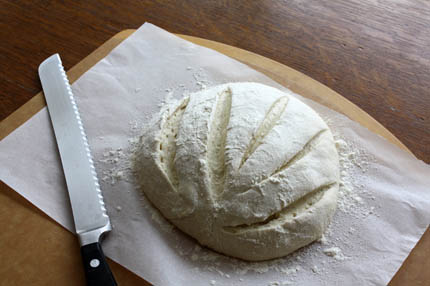
Cut the loaf with 1/4-inch deep slashes using a serrated bread knife. (If your slashes are too shallow you will end up with an oddly shaped loaf and also prevent it from splitting on the bottom.) If your dough is collapsing when you make the slashes, it may be that the dough has overproofed or your knife it dull and dragging the dough too much.
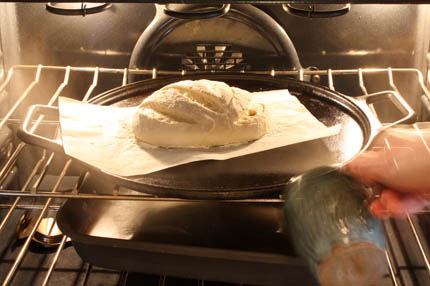
Slide the loaf into the oven onto a preheated stone (the one pictured below is cast iron) and add a cup of hot water to the broiler tray. Bake the bread for 30-35 minutes or until a deep brown color. As the bread bakes you should notice a nice oven spring in the dough. This is where the dough rises. To insure that you get the best results it is crucial to have an Oven Thermometer to make sure your oven is accurate.
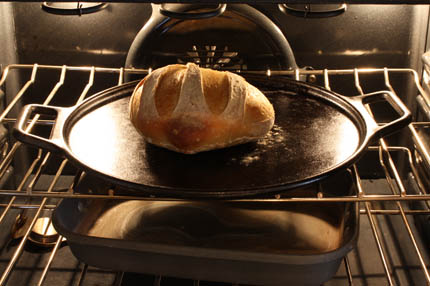
If you used parchment paper you will want to remove it after about 20-25 minutes to crisp up the bottom crust. Continue baking the loaf directly on the stone for the last 5-10 minutes.
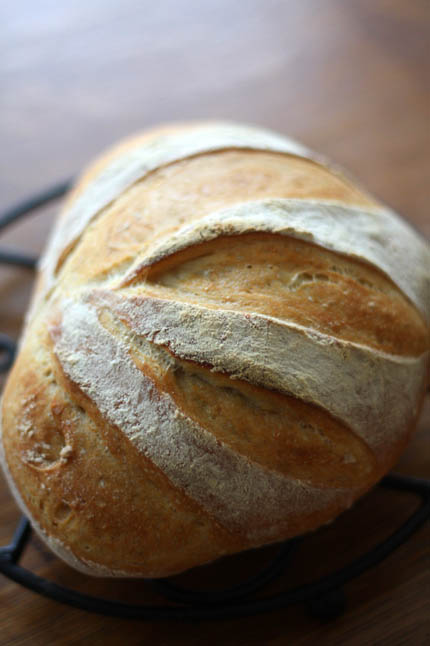
Allow the loaf to cool on a rack until it is room temperature. If you cut into a loaf before it is cooled you will have a tough crust and a gummy interior. It is hard to wait, but you will be happy you did! Make sure you have a sharp serrated bread knife that will not crush the bread as you cut.
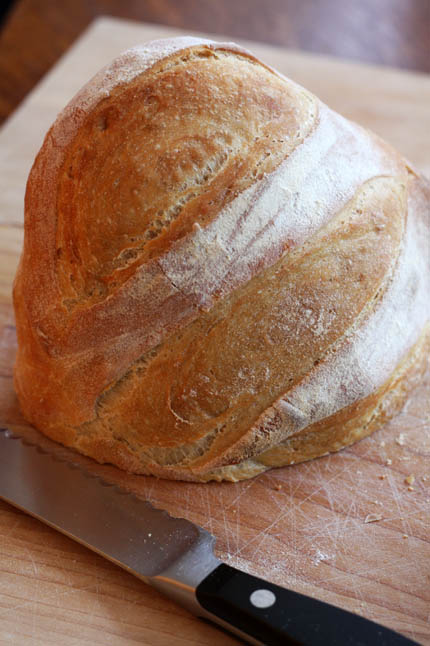
If you have any leftover bread just let it sit, uncovered on the cutting board or counter with the cut side down. If you cover a bread that has a crust it will get soggy.
Enjoy, have fun baking, and check out the FAQs page if you’re having trouble getting the bread to turn out the way you’d like.
Note: BreadIn5.com is reader supported–when you buy through links on the site, BreadIn5 LLC earns commissions.
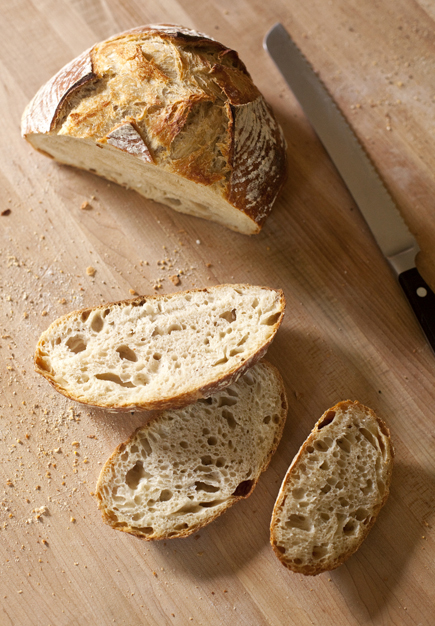
Your water quantities in the book are completely wrong 1000g flour and 920g water does not work
Bread turns out completely gooey in the middle
Proportions should be 5 flour to 3 water
Which of my books are you working from, and from which page number? The recipe you commented on here doesn’t use anywhere near that level of hydration. I think you may be confusing this recipe, which calls for 100% all-purpose white flour, with another that calls for whole wheat flour and added vital wheat gluten–that one requires a lot more water. Also, the 60% hydration dough you mention (5:3 ratio) as a standard is for traditional, stiffer dough that cannot be stored without losing rising power dramatically. My method relies on high-moisture dough to allow for storage, but note that I have many “Master” recipes, with different hydration requirements. The 75% hydration dough in the above post works quite well and bakes through consistently.
Dude, reading comprehension much?
6 1/2 cups (2 pounds/910 grams) all-purpose flour
3 cups (1 1/2 pounds/680 grams) lukewarm water
[SMH]
Been doing this read for years and years, a loaf per day, and it’s perfect. Sourdough without the time consumption of sourdough.
Thanks Maritza (so was I!)…
It’s lovely bread. It’s my current daily loaf, too. But please don’t call it sourdough. With commercial yeast it’s just not. I’m starting a wild yeast starter, too, to get my sourdough going again (fruit flies got it), but this is nice bread in the mean time. As for Mr Davies…. eh.
I didn’t say it was sourdough! Who’s Mr. Davies?
I follow the directions 910 g flour, 1 tblsp kosher salt and 1 tblsp yeast with 3 cups warm water and it’s perfect every time.
Thanks Mark, I think there was just a misunderstanding by that earlier commenter. Glad the recipes are working well for you.
Can you use a kitchen aid with dough hook to mix the dough? Or does it have to be done with a wooden spoon or Danish dough wisk?
Definitely can use the stand mixer!
Hi there! I love your recipes and have tried many, sometimes, like today, I bake two recipes at once!! :). Today I made 2 loaves and 2 baguettes made with a white strong dough and 2 loaves of cinnamon raisin-less bread… yum. I have noticed though that my bread always comes out looking a bit rough – not smooth like I think it should look like. Notice I am thinking it’s a purely visual flaw, the bread tastes great! I live in Colorado at 7400ft altitude and that can be a challenge with all sorts of baking. I am wondering if my dough is too dry, but how do I know it’s not too wet if I keep adding water?
The problem with high altitude is not usually drying, unless you’re in a desert region at altitude or in a very cold climate where hot dry heat in the winter is drying out your dough. The problem with altitude is about rising and collapse, which I’ve addressed in the books, and also here on the website. As for the hydration, you can follow the recipes exactly, especially if you’re weighing your ingredients. Volume measurement is always a little more tricky and, you may need to adjust as needed. Don’t keep adding water, or you’ll end up with a dough that won’t hold its shape.
Jeff,
you are awesome, the recipes are awesome, your vibe is awesome.
Keep creating and sharing with the rest of us, lowly bread-lovers.
… and thanks again!
I love all your recipes I have tried but would now like to bake in my Ninja smart cooker but how should adjust temperature and/or time.
Thank you
I haven’t tested with that device, only with crock pot type slow cookers. Type “Crock Pot Bread” into my Search Bar above for adjustments for that. Also, much more in my books.
Hello, I am going to try to make your bread for the first time, I am so excited. I was just wondering where Zoe got the clear plastic container that she uses to store the dough in the fridge. Thank you
I’ve used Cambro, available on Amazon: https://www.amazon.com/Cambro-RFS6PP190-Container-RFSC6PP190-Translucent/dp/B07FLF3L62?crid=DPWC95Z20961&keywords=cambro&qid=1671636875&s=home-garden&sprefix=cambro%2Cgarden%2C97&sr=1-10&th=1&linkCode=ll1&tag=arbrinfimiada-20&linkId=94e7ccb193166dfd55e51a1568b7bce5&language=en_US&ref_=as_li_ss_tl
…
But any non-reactive, non-airtight container will work (eg., stainless-steel pot with lid)
I just ordered two of those after seeing your post! On sale now!
Thanks Marc! Come back if you have questions about the recipes.
I didn’t want to buy more plastic bins (mine are full of water glassed eggs) so just used a 6 qt glass jar. Makes it prettier in the fridge, too, Will last longer, won’t retain smells if you want to use it for something else later.
Another tip, too:
Bake it in a cast iron skillet sprinkled with corn meal and prepped with parchment paper (preferably unbleached). I still use the pan of water.
Is there any way of continuously keeping a batch in the fridge or is it a case of when it’s gone it’s gone? It would be great to be able to replenish the stock and have a virtually unlimited supply!
Sure, just leave some in the bucket (a cup?)and build your new batch on top of it. For food safety reasons, don’t do this with recipe that have eggs or butter.
My usual go to bread loaf recipe uses a TBSP of honey. Can i add honey to your Master recipe and if so at what stage?
Certainly can! Mix it in with the water.
Can this recipe be doubled? I live at high elevation in an extremely dry climate. I find that I have to add a little extra water( I add a tbl at a time until it sticks together)to get it to become dough. It doesn’t affect the end product..
Definitely can double it!
Thank you! Love this recipe!
Glad it’s working for you! Much more in my books…
Can this dough be frozen before baking?
Sure can!
I am wondering, could I use this dough to make cinnamon rolls and raised doughnuts?
Better with my brioche or challah dough… this post details an unsweetened, un-enriched bread dough. That said, you can use it in my cinnamon roll recipes. Doughnuts too, but it’s going to be very different.
Thank you.
Can your brioche and challah recipe be saved for a few weeks also?
Also, on Zoe bakes she had added 1/4 cup oil to the recipe.
I am planning on making this tomorrow and wondered if the oil makes a less dense bread where this recipe makes a more rustic?
Thank you again. Looking forward to making it tomorrow.
The challah and brioche are better within 5 days or the flavor doesn’t really fit those loaves. As for the oil, that’s fine– a softer result, like the olive oil dough in the books. No less dense though, just different really.
I was given your new book, along with a 4 quart bucket for making your bread and I’m so excited to try it, but the recipe calls for a 6 quart bucket. Am I able to 1/2 your recipe? If it’s possible could you please give me the correct 1/2 weighted amounts for the ingredients?
You sure can halve the recipe (literally, just divide all the quantities by 2). Everything works better if you can weigh ingredients, but if you’re measuring flour with cup-measures, do it this way, as you see in my video: https://artisanbreadinfive.com/scoopandsweep
I made the original dough recipe. Wow! We are amazed. Already breezed through it. Going to make another batch today. I am wondering if wheat flour would make a difference in the measurements of ingredients? Or if I mix half wheat and half white? Would I need to alter the ingredients in anyway?
I was looking in the book, but did not see a reference regarding this.
I have not made the brioche or challah yet to try for cinnamon rolls. I ordered some better cinnamon from King Arthur. I hope it will make a difference as my store bought cinnamon does not seem to be very flavorful.
Thank you for your answeres. They help me to save on wasting my flour.
Linda
Glad the book is working well for you. There are partial whole wheat recipes, and even some 100% WW in the book you’re referencing here in this post–look at the index on page 382 (“whole wheat flour/bread”). Otherwise, put the words “whole wheat” or “whole grain” into the Search Bar here on the website for some whole wheat recipe ideas. Basically, you can swap in whole grains, but they require more water, and it takes some judgement and experimentation. If you use vital wheat gluten, you can get a better rise with WW, but that takes even more water. If you’re open to using vital wheat gluten, my whole grain book has more of that (https://artisanbreadinfive.com/buying-our-books/#healthy). Finally, my “Best-Of” book (https://artisanbreadinfive.com/buying-our-books/#best) has an approach to whole grains that doesn’t appear in the other books or here on the website (page 79-82).
Hi can this dough be used in a cast iron bread dome?
Sure can! Type in Dutch oven to the search bar above and you’ll see some posts about that. Much more in my books
Jeff, just wanted to pop in to say THANKS! I got your book a few years ago and my guests always ask how I have time to make bread. When we moved I didn’t have time to un0ack all my cook books. How happy am I that you have the recipe here for easy reference!
Happy Hanukkah, Merry Christmas, Happy Kwanzaa and have a wonderful New Year!
Thank you so much Sara, and to you and your family. I really appreciate when people write in here, and you should please come back whenever you have questions about the recipes!
Hello,
Still loving this recipe. I finally took the time to weigh mh dough and I am getting 3 x 1 lb balls of dough. What could be causing this?
If you total up weights for the ingredients, they weigh 3.5 pounds (2 pounds flour plus 1.5 pounds water), so if you divided that by four, you end up with four balls of dough that weigh just under 0.9 pounds (.875 to be exact). So it was always a rough approximation. A metric version with the same proportions (1000 grams flour, 750 grams water) makes closer to 1 pound loaves (.96 pounds). You can scale up the recipe 25%, 50%, or just double it– to get larger loaves and more dough. You’ll need proportionally bigger storage vessels.
But I can’t explain why you’re getting only 3 pounds of dough from that recipe!
Your book with a freshly baked loaf has been my favourite gift to give for years! 🙂
Thanks for the kind words, and for spreading the word!
First time bread maker here-
I have Fleischmann’s active dry yeast. It states in the directions to dissolve 1 tsp of sugar with the yeast packet to activate yeast before and then to follow your recipe.
Do I need to add the sugar to activate the yeast for this bread recipe or do I just use the yeast by itself?
Modern yeast doesn’t really need that, though. It does speed up the startup a little bit. I don’t usually bother with it and it doesn’t matter which brand you’re talking about
I tried to make cinnamon raisin bread in a full loaf pan. Added 2 eggs, half cup sugar, some milk, vanilla, cup of raisins to the basic dough and the mixed spices. Added just enough flour to be able to handle it. Outside was beautiful but the inside was still gummy after baking 375 convection for 35 minutes. Still not done after 45 minutes. I think there was enough flour Added to account for the little bit of milk. Not sure why the center wouldn’t get done.
The most common reason is that the oven isn’t at the temperature you thought it was. Have you checked it with something like https://amzn.to/3Zl7Ozg ? That said, this isn’t a recipe from my books or here on the website, so this will take some testing. If your oven’s up to temp, and you want to egg-enrich my recipe that I use in the one on page 330 of the book you’re posting about here, you may need to decrease the temp to 350 and bake for longer. Testing is everything.
Also, if all you did was add eggs and liquid to my basic recipe, you ended up with a dough that’s much wetter than my intention ever was. If you add that much liquid, you have to balance it with additional flour or you will get the result exactly as you’ve seen
Hi, and thanks for this great recipe! I have loved impressing my family with hot fresh bread! My only trouble is that the dough does not seem to last the full two weeks without getting kinda weird. Meaning, when I bake that last bit it seems like the color is off and the flavor, too. Also, I am not sure how much I am supposed to handle it after it has been in the fridge, but I would love to be able to knead it a bit to mix around the part that is overly moist- usually the part that has been at the top. Is this okay to do?
Well, some folks just aren’t crazy about the fully-aged version of the dough. It tends to be denser, and with a stronger sourdough flavor. One thing that helps with the flavor at 2 weeks is to go with a low-yeast version (http://www.artisanbreadinfive.com/2007/12/19/low-yeast-version-of-our-master-recipe). And if you handle it a lot when fully aged, you may get a too-dense result. What I do is pour off the excess liquid and shape with a lot of dusting flour. For your taste though, I’m guessing you should freeze the dough at the 1-week mark.
I have a question about weights. My flour is Wegman’s All Purpose Flour, and the package says 1/4 cup is 30 grams, or about 4.3 ounces per cup. I think you say that 1 cup is 5 ounces. How much should I use?
At least 4.8, which I rounded to 5. The difference is because I’m measuring this way: http://www.artisanbreadinfive.com/2010/04/28/how-we-measure-our-flour-using-the-scoop-and-sweep-method . Some do it by “spoon-and-sweep” instead. But if you have a scale, it’s better to go by weight rather than cup-measure.
can this recipe be made with whole wheat flour and can you add seeds, oats, etc.?
Yes, but you need to adjust the water– WW takes more to achieve the same high hydration, about a quarter-cup to a half-cup, depending on the brand of whole wheat flour and the proportion you’ve swapped (at small amounts, up to a cup or so, you don’t need much adjustment at all, if any). Much more in the books, and here on the website as well. Do searches in the Search Bar above, for “whole wheat” and “whole grain.” Check out the videos on my YouTube so you can get a sense of how wet this dough should look.
Can you add sour dough starter to aster Recipe ? If so how much
Have you seen my post on this? Type the word sourdough into the search bar on my homepage, and if that doesn’t give you the answer, get back to me here…
I’ve been making this bread for the past few weeks and been really enjoying it!! I also managed to get a hold of a copy of your book in the U.K.
However, I’m finding that when I do the 40-90min counter rest, the dough spreads so much regardless of how tightly I shape the ball initially. This results in quite a large and flat loaf. The crumb is still good though. But what am I doing wrong? How can I stop it from spreading so much after shaping?
Which version of the book are you using? And which recipe? US version, or UK version? What type of flour are you using? How are you measuring it?
I’m using this the master recipe in the updated book (new artisan bread in 5 mins).
I’ve used plain white flour. I’m measuring in grams, weighing everything out!
Two possibilities here, first that you’re not doing quite enough gluten cloaking before you set the loaf down. The other possibility is it the flour in the UK typically doesn’t have as much protein as North American ones, unless it’s specifically sold as “strong” flour. Given that, you’re probably just going to have to decrease the water a bit… Maybe two to four tablespoons. See how the dough looks
Have you ever tried this with fresh milled flour?
I looked at the conversion for higher protein flour but there wasn’t an option for fresh milled flour.
Sure, see my post on that by typing “fresh ground” into the Search Bar above, and let me know if you have questions about it.
Hello,
My husband and I are in the process of making the bread, however after letting it rise for two hours, we went to pull some out to make the boule and the dough just breaks, there is no stretchiness to it. Do you know what we did wrong?
Sounds like it’s too dry. Did you use a high protein flour instead of all purpose? That’ll do it. Also, how did you measure, did you use the scoop and sweep method? You can see a video of me doing that if you put the words, “scoop and sweep” into the search bar above. That will not be important obviously, if you weighed your ingredients.
Thank you, we did not weigh the flour, but the bag of flour we used was the same weight as what was needed for the recipe. We used an emmer farro flour, it was milled locally. We put it in the refrigerator overnight. After taking it out of the refrigerator it was still breaking apart when pulling some from the container. To me it felt too wet.
That’s the answer to the problem… You swapped in a flour that this recipe wasn’t designed to handle without a major water adjustment. The protein/gluten content in that flour is much lower, and for that reason and others, it’s going to perform very differently. You’ll need to experiment with the water level (probably less, but I don’t know how much less). Also, you can’t trust the weight on the bag when using it in a recipe.
Hi Jeff
We love the bread. I have a question though
Have you ever cooked a double batch, like a two pound loaf
Would love big slices for toast etc and the bread at the store we like is big so I’m trying to replicate
Have everything down but not sure on the cooking time
Thanks!
Have you seen this post? https://artisanbreadinfive.com/2012/03/20/how-to-make-a-2-pound-loaf/ A lot depends on the characteristics of your oven, and you may not need to increase baking time quite so much.
Is there a specific internal temperature the bread should reach when done?
I’m not a big fan of instant read thermometers that are typically available and are based on a metal probe. A lot depends on where you exactly place the probe, so it’s not the most accurate thing in the world. The infrared ones are supposed to be better, but I just use the appearance of the loaf. If you want to use a thermometer, this particular loaf should read 205 to 210° f.